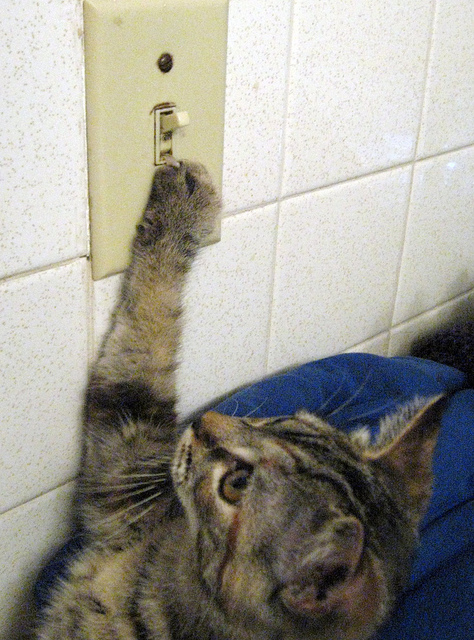
Introduction to JavaScript
Class 2
Let's Look Back

Photo credit: Deepak Bhatia cc
Code Search
In this code, spot the comment, variables, and operators.
var billPreTip = 10;
var tipPercent = 0.15; // Can be changed
var billTip = billPreTip * tipPercent;
var receipt = 'Meal: ' + billPreTip + ' Tip: ' + billTip +
' Total: ' + (billPreTip + billTip);
console.log(receipt);
Functions
Functions are separable, reusable pieces of code.

Photo credit: Rick Payette cc
Declaring Functions
To declare (create) a function, you can give it a name, then include all the code for the function inside curly brackets {}
function parrotFacts() {
console.log('Some parrot species can live for over 80 years');
console.log('Kakapos are a critically endangered flightless parrot');
}
Functions can have multiple lines.
Using Functions
To invoke (use) a function, you type its name, followed by parenthesis ()
parrotFacts();We'll talk about what can go inside those parenthesis in a minute! For now, leave them empty.
What's going on here?
A function is a group of code you can reuse many times. Whenever you invoke a function by using it's name, you tell the browser to run the code inside the function.
You must declare a function before you can use it.
Let's Develop It
Write a function that outputs a sentence. Then invoke that function later in your code.
Arguments
Functions can accept input values, called arguments.
function callKitten(kittenName){
console.log('Come here, ' + kittenName + '!');
}
callKitten('Fluffy'); // outputs 'Come here, Fluffy!'
function addNumbers(a, b){
console.log(a + b);
}
addNumbers(5, 7); // outputs 12
addNumbers(9, 12); // outputs 21
Arguments
You can also pass variables into functions. These variables do not need to have the same name as the function arguments.
function addOne(num){
var newNumber = num + 1;
console.log('You now have ' + newNumber);
}
// Declare variables
var numberOfKittens = 5;
var numberOfPuppies = 4;
// Use them in functions
addOne(numberOfKittens);
addOne(numberOfPuppies);
Let's Develop It
Write a simple program to combine a first name and a last name inside a function. Then update the function to accept a first and last name as arguments.
Returning Values
You can have a function give you back a value, to use later.
function square(num) {
return num * num;
}
console.log(square(4)); // outputs '16'
var squareOfFive = square(5); // squareOfFive equals '25'
return will immediately end a function.
Let's Develop It
Add a return statement to your 'name' function. Use that function to set the value of a variable.
Variable Scope
The scope of a variable determines where it's value is accessible throughout your program.

Global Scope
A variable declared outside of a function has a global scope and can be accessed anywhere, even inside of functions.
var awesomeGroup = 'Girl Develop It'; // Global scope
function whatIsAwesome() {
console.log(awesomeGroup + ' is pretty awesome.'); // Will work
}
whatIsAwesome();
Local Scope
A variable declared inside a function has a local scope and can only be accessed within that function.
function whatIsAwesome() {
var awesomeGroup = 'Girl Develop It'; // Local scope
console.log(awesomeGroup + ' is pretty awesome.'); // Will work
}
whatIsAwesome();
console.log(awesomeGroup + ' is pretty awesome.'); // Won't work
Boolean Variables

Photo credit: elycefeliz cc
Boolean Variables
Boolean variables represent the logical values true and false
var catsAreBest = true;
var dogsRule = false;
Boolean Variables
Some values are considered falsy and will evaluate to false in a Boolean context.
// the following variables will evaluate as false
var myName = '';
var numOfKids = 0;
var isMarried; // remember a variable with no value is undefinednull and NaN will also evaluate as false.
Everything else evaluates as true.
Control Flow

The if statement
Use if statements to decide which lines of code to execute, based on a condition.
if (condition) {
// statements to execute
}
var age = 30;
if (age > 18) {
console.log('You are an adult');
}Comparison Operators
| Example | Name | Result |
|---|---|---|
a == b |
Equal | TRUE if a is equal to b (can be different types). |
a === b |
Identical |
TRUE if a is equal to b, and the same type. |
a != b |
Not equal | TRUE if a is not equal to b (can be different types). |
a !== b |
Not identical | TRUE if a is not equal to b, or they are not the same type. |
a < b |
Less than | TRUE if a is strictly less than b. |
a > b |
Greater than | TRUE if a is strictly greater than b. |
a <= b |
Less than or equal to | TRUE if a is less than or equal to b. |
a >= b |
Greater than or equal to | TRUE if a is greater than or equal to b. |
Watch out!
Don't mix up = and == and ===

Photo credit: Eugene Zemlyanskiy cc
Let's Develop It
Make a variable called "temperature". Write some code that tells you to put on a coat if it is below 50 degrees.
Even more control flow

Photo credit: Thomas Hawk cc
The if/else statement
Use else to provide an alternate set of instructions.
var age = 30;
if (age >= 16) {
console.log('Yay, you can drive!');
} else {
console.log('Sorry, you have ' + (16 - age) +
' years until you can drive.');
}
The if/else statement
If you have multiple conditions, you can use else if.
var age = 30;
if (age >= 35) {
console.log('You can vote AND run for President!');
} else if (age >= 30) {
console.log('You can vote AND run for the Senate!');
} else if (age >= 18) {
console.log('You can vote!');
} else {
console.log('You can\'t vote, but you can write your representatives.');
}
Let's Develop It
Modify your "wear a coat" code for these conditions:
- If it's less than 50 degrees, wear a coat.
- If it's less than 30 degrees, wear a coat and a hat.
- If it's less than 0 degrees, stay inside.
- Otherwise, wear whatever you want.
Logical Operators
| Example | Name | Result |
|---|---|---|
a && b |
And | TRUE if both a and b are TRUE. |
a || b |
Or | TRUE if either a or b is TRUE. |
!a |
Not | TRUE if a is not TRUE. |
Using logical operators
You can use these operators to combine conditions.
var age = 30;
var yearsAsCitizen = 30;
if (age >=30 && yearsAsCitizen > 9) {
console.log('You can run for the Senate!');
} else {
console.log('You are not eligible to run for the Senate');
}Let's Develop It
Add a logical operator to your "what to wear" program.
You did it!

Photo credit: OnceAndFutureLaura cc
Resources
- JavaScript Guide, from the Mozilla Developers Network.
- Code Academy, with interactive JavaScript lessons to help you review.